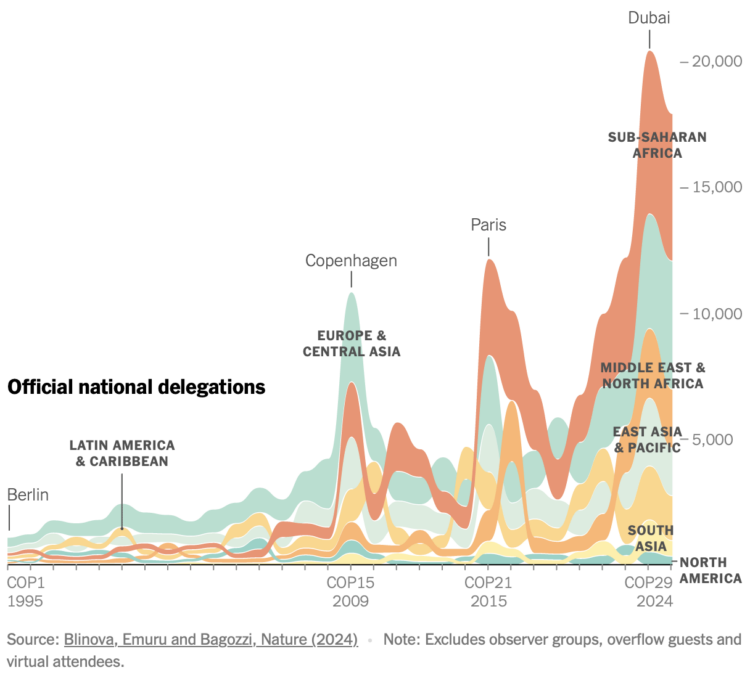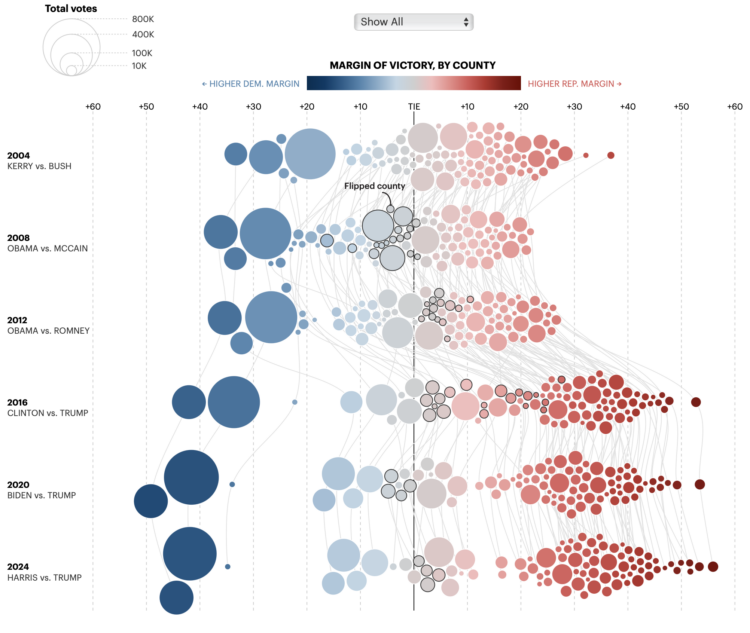You know the John Snow map that highlights a cholera outbreak in London, from 1854. Alex Selby-Boothroyd made a 3-D-printed version that brings the stacked counts out of the map.
-
Daren Jannace animated 30 frames per day for one year and then put it all together at 30 frames per second. The full video, with audio captured on Daren’s phone during the year, is a 365-second video that represents a year in his life. It’s called 10,946.
[via kottke]
-
Memento Movi, a mini-app by Michael Condouris, is what you get when you use movies as a progress bar for life expectancy. Enter your birthdate and expected lifespan. Then select a movie from the list. The percentage of your life that you’ve lived is translated to the percentage through the movie you would be, which gives you the frame in the movie.
I swear this was made just for me. [via Waxy]
-
Martin Wattenberg drew up a live visualization that shows colors mentioned in Bluesky posts, via the firehose. Just let the wave of calm wash over you.
I’m sure there are many more mashups to come, but I’ll probably shift anymore sharing to Bluesky itself, so as not to inundate you with a firehose about using the firehose. It’s just refreshing to see data flowing freely after companies moving the other direction over the past several years.
-
Members Only
-
Our World in Data is a hub for research and reliable data to measure the progress of the world. You’ve always been able to download data from the site, but they just made it easier with more detailed exports and an API:
For users who work with automated workflows, computational notebooks, or custom applications, we now offer direct URLs to access data in CSV format and comprehensive metadata in JSON format. This is the same data and metadata included in the zip file download package described above.
Just like with the download package, you can fetch the complete data or only the subset of the data currently displayed in the chart. You can also choose between longer column names that are easier to read for humans or shorter column names that are often more convenient to use in code.
Great news.
-
We like to imagine a world of autonomous robots that take care of tedious tasks so that we don’t have to. Chris Fenton likes to imagine robots made of garbage that roam around his backyard, and Grasso was born:
Who says AGI has to be super intelligent just to be A, G and I? Grasso is driven by a kind of python ‘madlib’ wrapped around two LLMs (one multi-modal, one text-only). The outer loop takes a photo with its webcam and feeds it into a multi-modal LLM to generate a scene description. That scene description is then inserted into a prompt (“This is what you currently see with your robot eyes…”) that ends with “Choose your next action” and presents a list of actions the robot can take, some of which are ‘direct’ commands, and others that are ‘open ended’ and let Grasso finish the action prompt however it chooses.
-
Foursquare, which I thought was still a location sharing app but is a data platform now, open sourced a layer of 100 million points of interest in an effort to build and maintain a global database:
[L]et’s now consider the challenge of creating and maintaining a real-world-synced place database. As our CTO Vikram Gundeti detailed in a recent blog on our newly re-launched Place Engine, to do this well requires an operating system powered by human-in-the-loop confirmations harmoniously orchestrated with cutting edge digital discovery systems to actively curate a database representative of the current world. In short, building an accurate global database of POI is an extraordinarily difficult task both from a technical perspective and from a capital resource perspective.
This leads to our belief that, absent a global proprietary distribution platform like Google Maps, building a comprehensive and accurate base layer of place data is indeed a problem best solved by an open source community.
You can access the dataset now.
-
 Speaking of data blankets, the knitting club in the area I live has an annual tradition of making sweaters for trees in their downtown. One of the trees was wrapped with a temperature blanket.
Speaking of data blankets, the knitting club in the area I live has an annual tradition of making sweaters for trees in their downtown. One of the trees was wrapped with a temperature blanket.Each color corresponds to a temperature range. Each knitted row reflects the high temperature for each day throughout the past year. The bottom starts with September 1, 2023.
Let’s get more data into the physical world.
-
Jesse Gwinn, from NOAA, was at sea on a mapping expedition and to pass the downtime between tasks, she crocheted a bathymetry blanket:
I assigned 11 colors to different depth ranges: reds and yellows for shallower waters (~2,000-4,000 meters/1.2-2.5 miles), blues and purples for deeper areas (~4,000-6,000 meters/2.5-3.7 miles). Each vertical row contains two colors, illustrating the deepest and shallowest points recorded in a 6-hour period. The relative location of the color change is positioned to represent the average depth of the seafloor for that timeframe. […] The finished blanket contains 97 rows, representing 582 hours (a little more than 24 days) worth of bathymetry data collected using multibeam sonar.
-
Bluesky firehose fun continues. Jared Short shows emoji usage as rain drops that fall down the screen. Larger drops represent longer posts.
Or, if the Matrix aesthetic is your thing, Short did that too:

-
To demonstrate how easy and cheap it is to access the Bluesky firehose, Final Words listens for deletion events and lets them fly and vanish from existence.
-
Bluesky has a relatively easy-to-use firehose that lets you dip into the stream of events through the platform. Theo Sanderson made this tunnel view to immerse yourself in the stream of consciousness composed by Bluesky users.
This is feeling a lot like early Twitter, which makes me think we should enjoy it while it lasts.
-
The 58-year-old Mike Tyson fought the 27-year-old Jake Paul, likely wrapping up Tyson’s boxing career that started in 1985 when he was 18. Given the big age difference in the final fight, I wondered the age of past Tyson opponents. This is the timeline.
-
For the New York Times, Mira Rojanasakul visualized annual participation in the United Nations Climate Change Conference, which has been running every year since 1995.
If you think of the numbers as a proxy for the nations that care about climate change, things don’t look great for North America, but the shifts also provide a window into the politics of caring.
-
Make the Chart: Interactive Line Chart with Ghost Trails
Using faded lines to show the overall changes in a time series and to provide a point of reference for the present.
-
The New York Times used swooping arrows to show vote swings left and right for the 2016, 2020, and 2024 elections. A shift left makes the section of an arrow blue, and a shift right makes a section of the arrow red. They show these arrows for demographic groups, too, which have static sizes, but the map above scales the arrows for electoral votes.
I was trying to figure out where I saw this method before. Then I saw it:

More specifically, the wordless version:

Then I had to eat lunch.
-
For the Minnesota Star Tribune, Yuqing Liu and C.J. Sinner show how the margin of victory changed each presidential election in Minnesota. Each bubble represents a county, size shows total votes, and diverging color scale represents the margin of victory for Democrat and Republican.
My affinity for force-directed bubbles contractually requires that I share this.
-
Members Only
-
In 1935, the United States Congress passed the Social Security Act to provide financial support to those 65 years and older. Full retirement age would slowly rise to 67 by 2022. We can see how this changed the scales of who works and for how long through employment rates by age and time.


















 Visualize This: The FlowingData Guide to Design, Visualization, and Statistics (2nd Edition)
Visualize This: The FlowingData Guide to Design, Visualization, and Statistics (2nd Edition)










